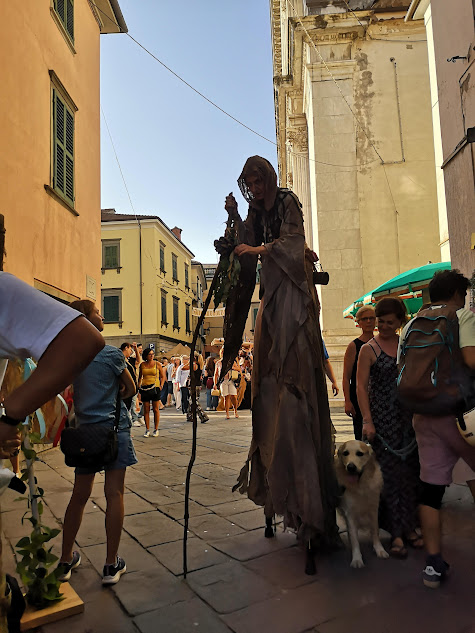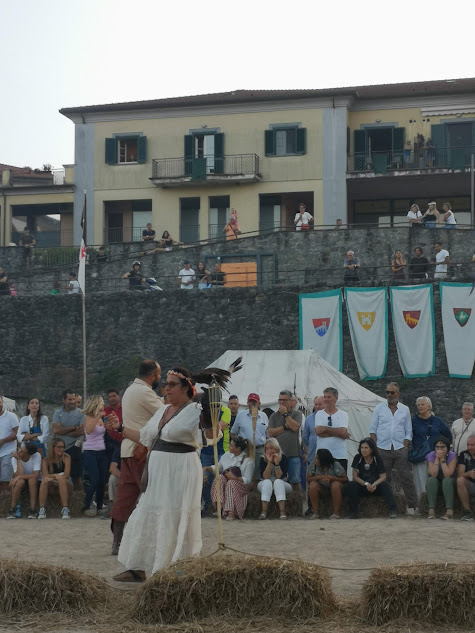
Nestled in the northern reaches of Tuscany, the medieval town of Pontremoli hosts one of Italy’s most immersive and vibrant historical festivals—Medievalis. This annual event, held each August, transforms Pontremoli into a living museum, transporting visitors back to the year 1226, when the town was granted the status of a ”Libero Comune” (Free Commune) by Emperor Frederick II. With its meticulously organized reenactments, cultural performances, and medieval markets, Medievalis is an experience that should not be missed by anyone with a passion for history, culture, or simply a desire to experience the magic of the Middle Ages.
The Historical Significance of Medievalis

Medievalis celebrates a pivotal moment in Pontremoli’s history. In 1226, Emperor Frederick II, recognizing the strategic importance of the town along the Via Francigena—a major pilgrimage route connecting northern Europe to Rome—granted Pontremoli autonomy as a Free Commune. This designation allowed the town to govern itself and flourish as a key crossroads for pilgrims, merchants, and armies traveling between Lombardy and Tuscany.
Pontremoli’s role as the ”key and gate” of Tuscany made it a focal point of medieval politics and trade, contributing to its rich cultural heritage. The town’s medieval architecture, including the imposing Castello del Piagnaro, is a testament to its historical importance. Medievalis honors this legacy by recreating the atmosphere of the 13th century, offering visitors a unique opportunity to step back in time.
What to Expect at Medievalis

Medievalis is more than just a festival; it is a comprehensive reenactment of medieval life, meticulously organized by the Compagnia del Piagnaro. The event typically spans four days, from August 22 to 25, and is packed with activities that cater to all ages.
1. Historical Reenactments and Performances
The heart of Medievalis lies in its historical reenactments. The streets of Pontremoli come alive with knights in armor, merchants peddling their wares, and townspeople dressed in period costumes. One of the highlights is the reenactment of the granting of the Free Commune status, where the town’s mayor and citizens pay homage to Frederick II in a grand ceremony.
Another key event is the Palio di Medievalis, a fierce competition among the town’s districts—Sommoborgo, Immoborgo, and Contado. Participants compete in various medieval sports, including archery, jousting, and foot races, with the winning district awarded the coveted Palio banner.
2. Medieval Markets and Crafts
Throughout Medievalis, the town’s streets are lined with medieval markets, where artisans display their crafts and traditional foods are prepared and sold. Visitors can browse through stalls selling handmade jewelry, leather goods, pottery, and other items inspired by medieval craftsmanship. The markets also offer a taste of medieval cuisine, with vendors serving up dishes made from recipes passed down through the centuries.
3. Cultural and Educational Activities
Medievalis is not just about entertainment; it also offers a wealth of educational opportunities. The festival includes guided tours of Pontremoli’s historic sites, including the Castello del Piagnaro and the Museum of the Stele Statues. These tours provide insight into the town’s history and the significance of the stele statues—ancient stone carvings dating back to the 4th millennium BC that are unique to the Lunigiana region.
Workshops and demonstrations on medieval crafts, such as blacksmithing, weaving, and calligraphy, are also held throughout the festival. These activities allow visitors to engage directly with the skills and techniques that were essential to life in the Middle Ages.
4. Evening Spectacles
As night falls, Pontremoli becomes the stage for a series of spectacular evening performances. Fire dancers, jesters, and musicians take to the streets, creating an atmosphere of magic and wonder. The festival culminates in a grand procession through the town, followed by a fireworks display that lights up the night sky, marking the end of the celebrations.
The Stele Statues of Lunigiana
A visit to Pontremoli during Medievalis would not be complete without exploring the Museum of the Stele Statues. Housed within the Castello del Piagnaro, this museum is dedicated to the ancient stone carvings known as stele statues, which are among the most significant archaeological finds in Europe.
The stele statues, which date back to the Copper and Iron Ages, are mysterious figures carved from sandstone by the ancient inhabitants of the Magra Valley. These statues depict human forms, often abstract and stylized, and are believed to have served religious, funerary, or territorial marking purposes, though their exact function remains a subject of debate among scholars.
The museum’s collection includes over thirty statues, making it the largest and most important repository of these artifacts. The exhibition is designed to provide visitors with an immersive experience, offering both historical context and emotional engagement with these ancient objects. The museum’s location within the castle also offers stunning views of Pontremoli and the surrounding countryside, making it a must-visit for anyone attending Medievalis.
How to Get to Pontremoli
Pontremoli is located in the northern part of Tuscany, in the province of Massa Carrara. It is easily accessible from major cities such as Parma and La Spezia, making it a convenient destination for travelers.
From Parma
By Car: The journey from Parma to Pontremoli takes approximately 1 hour and 20 minutes by car. Travelers can take the A15 motorway (Autostrada della Cisa) south towards La Spezia, exiting at Pontremoli. The route offers scenic views of the Apennine mountains and the lush valleys of Lunigiana.
By Train: Pontremoli is also accessible by train from Parma, with a direct route that takes about 1 hour and 30 minutes. Trains run regularly, and the journey offers a relaxing way to enjoy the picturesque landscape of the region.
From La Spezia
By Car: The drive from La Spezia to Pontremoli is relatively short, taking about 45 minutes. Travelers can follow the A15 motorway north towards Parma, exiting at Pontremoli. The road passes through the beautiful Tuscan countryside, with opportunities to stop and explore small villages along the way.
By Train: Trains from La Spezia to Pontremoli run frequently, with a travel time of approximately 45 minutes. This option is ideal for those who prefer not to drive, allowing them to sit back and enjoy the scenic journey.
Where to Eat in Pontremoli
Pontremoli offers a variety of excellent dining options that showcase the traditional flavors of the Lunigiana region. Osteria della Bietola is a must-visit, located in the heart of the historic center. This cozy spot serves authentic Lunigiana cuisine, including local specialties like testaroli and torta d’erbi. For a taste of history, visit Antica Pasticceria degli Svizzeri, a pastry shop with a charming Art Nouveau interior, famous for its Spongata and Amor pastries. For a unique aperitif experience, head to Bar Luciano in Piazza del Duomo, where you can try the local cocktail Bianco Oro( Wanderlog, Visit Tuscany, My Travel in Tuscany).
Where To Stay in Pontremoli.
If you’re looking for a place to stay in Pontremoli, you have a variety of options that blend comfort with authentic local charm. In the historic center, Casa Cavour is a popular guesthouse known for its central location and welcoming atmosphere. For those who prefer a more serene experience surrounded by nature, agriturismos like Agripodere Il Falco and Costa D’Orsola offer a relaxing retreat in the hills around Pontremoli. These locations are ideal for travelers with a car who want to explore the scenic beauty of the Lunigiana region at their own pace (Dove Alloggiare, Toscana).
Conclusion
Medievalis of Pontremoli is more than just a festival; it is a journey into the heart of Tuscany’s medieval past. Whether you’re a history enthusiast, a lover of culture, or simply looking for a unique travel experience, Medievalis offers something for everyone. From the thrilling reenactments and vibrant markets to the educational workshops and evening spectacles, this event provides a rare opportunity to step back in time and experience the magic of the Middle Ages.
As you plan your visit, take the time to explore Pontremoli’s rich history, including the enigmatic stele statues that have puzzled and fascinated scholars for centuries. With its blend of cultural heritage, stunning landscapes, and warm hospitality, Pontremoli is a destination that promises to leave a lasting impression on all who visit.
Upptäck mer från Emilia Delizia
Prenumerera för att få de senaste inläggen skickade till din e-post.